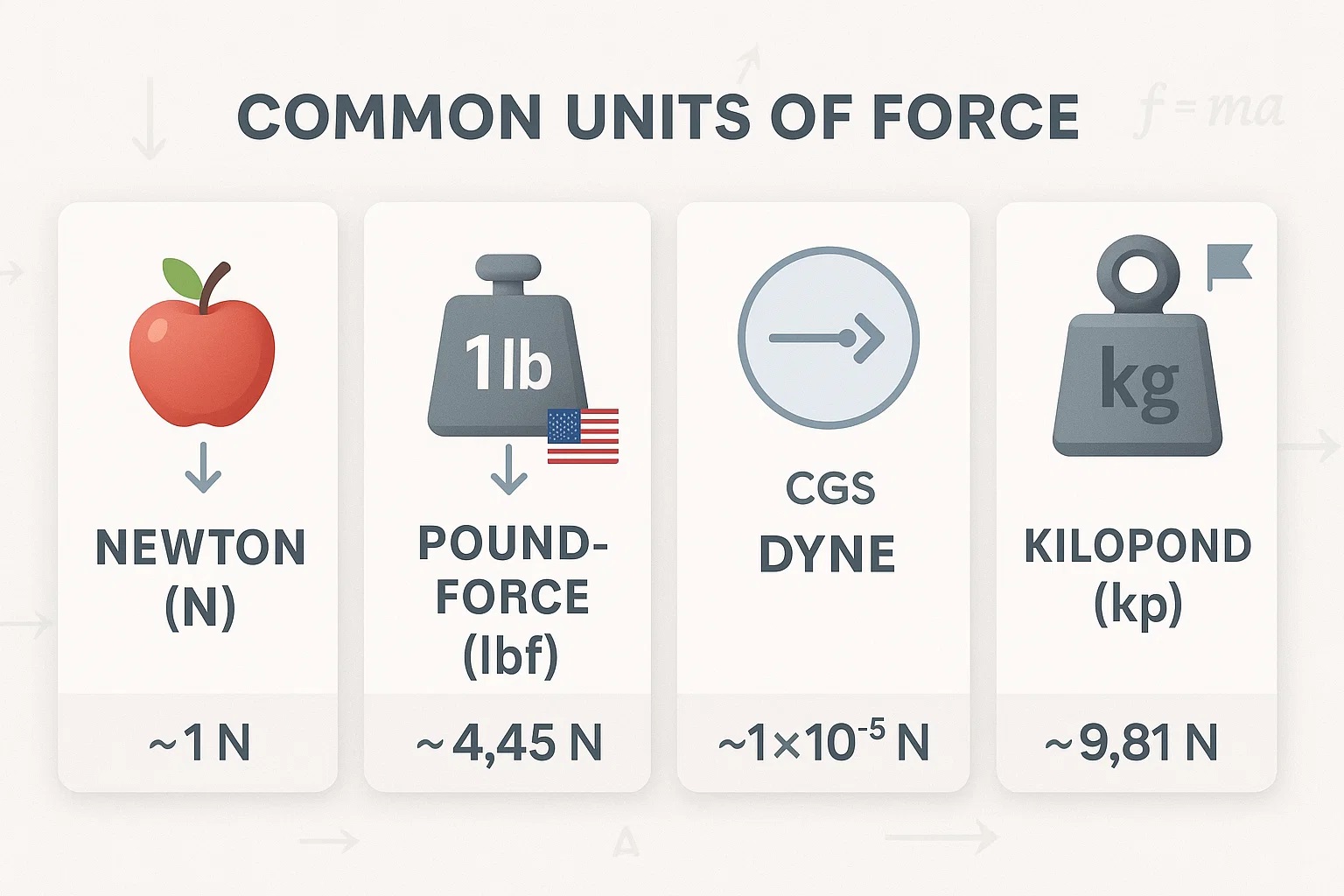Whether you’re a student exploring the basics of Newtonian physics or a professional handling measurements like pound-force or newtons, understanding how force works — and how to convert it — is crucial. From something as simple as a hand push to the engines powering rockets, force is what drives motion and interaction in our world.
This guide goes beyond just using a force converter — we’ll explore what force really is, the different types you encounter, and the common units used around the world. We’ll also show how a force unit converter simplifies your work and where force appears in science, engineering, nature, and even history.
What Is Force?
Force is the reason things move, slow down, or come to a stop. It’s present in everyday life, whether you’re pushing a grocery cart or feeling gravity pull you down. In scientific terms, force is any interaction that changes an object’s motion.
Newton’s Second Law sums it up neatly:F = m × a
(Force = Mass × Acceleration)
This means that the heavier something is, or the faster you want it to move, the more force you’ll need. The official SI unit for force is the newton (N), named after Sir Isaac Newton. One newton is the force needed to accelerate a 1-kilogram object by 1 meter per second squared.
So lifting a 1-liter bottle (about 1 kg)? You’re applying close to 10 newtons of force — thanks to gravity.
Types of Force You Might Encounter:
-
Gravitational – The Earth's pull on objects
-
Electromagnetic – Think electricity and magnets
-
Nuclear – Holding atoms together
-
Contact Forces – Like friction, tension, or pressure
If you're dealing with pressure exerted across surfaces (like tires, hydraulics, or weather systems), consider using a Pressure Converter to translate between Pascal, psi, and more.
And since force is linked to acceleration, a Speed Converter can help when working with changing speeds, especially in motion and mechanics problems.
Units of Force Around the World
Force may be a universal concept, but it’s measured in various ways depending on the region and the industry. That’s why force converters are so valuable — they help translate between systems like SI (metric) and imperial, or older, less common units.
Newton (N) – The Global Standard
Most of the world uses the newton, the SI standard unit for force. It’s simple, precise, and widely adopted in science and engineering.
Pound-Force (lbf) – Common in the U.S.
In the U.S., you’ll often see pound-force, which is the gravitational force acting on one pound of mass. Though it sounds like weight, it’s technically a force — and it’s used frequently in fields like aerospace, construction, and mechanics.
Historical and Smaller Units
- Dyne: Part of the older CGS system.
1 newton = 100,000 dynes - Kilopond (kp): Also called kilogram-force.
1 kp ≈ 9.81 newtons
Quick Comparison Table
|
Unit |
Symbol |
Equivalent in Newtons (N) |
|
Newton |
N |
1 N |
|
Pound-force |
lbf |
≈ 4.44822 N |
|
Dyne |
dyn |
1 N = 100,000 dyn |
|
Kilopond |
kp |
1 kp = 9.80665 N |
These units emerged from different systems and needs — but with modern tools, switching between them is now fast and seamless.
What Exactly Is 1 Newton?
It may seem abstract at first, but 1 newton is a very practical and easy-to-understand unit when you break it down.
Let’s look again at Newton’s Second Law:F = m × a
So:
-
Force (F) is in newtons
-
Mass (m) is in kilograms
-
Acceleration (a) is in meters per second squared
That means:1 N = 1 kg × 1 m/s²
In plain terms, Applying 1 newton of force moves a 1-kg object at a rate of 1 meter per second squared. It’s a clean, logical unit that aligns with real-world behavior and fits seamlessly into science and engineering calculations.
Force Unit Conversion
Whether you're reviewing scientific papers, solving equations, or just need a quick reference — knowing how to convert between units of force can save time and prevent costly mistakes.
Here’s a useful reference:
|
Unit Name |
Symbol |
Equivalent in Newtons (N) |
Notes |
|
Newton |
N |
1 N |
SI base unit |
|
Pound-force |
lbf |
1 lbf ≈ 4.44822 N |
Common in U.S. industries |
|
Kilogram-force (Kilopond) |
kgf / kp |
1 kgf ≈ 9.80665 N |
Based on Earth's gravity |
|
Dyne |
dyn |
1 dyn = 0.00001 N |
Used in CGS system |
|
Ounce-force |
ozf |
1 ozf ≈ 0.27801 N |
Smaller imperial unit |
This table helps you convert force units at a glance. For more precise work, especially in engineering or physics research, using a digital force converter ensures accuracy down to decimal points.
Fun fact: NASA often needs to convert between pound-force and newtons during international missions — even in outer space, unit conversion is key!
How to Use a Force Converter
The force converter is a quick and easy way to switch between different units of force, especially when you're dealing with unfamiliar measurements like pound-force or kilopond. Whether you're a student solving physics homework or an engineer checking calculations, it saves time and reduces errors.
Step-by-Step Guide
-
Input Your Value – Type the number you want to convert (e.g., 100).
-
Choose the Current Unit – Select the unit you’re starting with: N, lbf, kp, etc.
-
Pick Your Desired Unit – Choose the unit to convert to.
-
Get the Result Instantly – No manual calculations — the tool does it for you.
For example:100 newtons ≈ 22.48 pound-force
That’s a useful stat if you’re reading U.S. equipment specs or converting historical engineering texts.
Need to work with torque or rotational force? Tools like the inch-lbs converter, inch-pounds calculator, or lbs to newton converter can round out your toolbox.
Check out Conversion section for automatic conversion fast and easy


